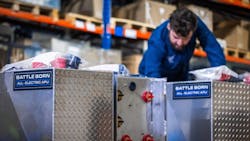The smart way to protect your cranking battery this winter
Winter is here, and for medium and heavy-duty truck operators, that means one thing: battery struggles. Dead cranking batteries are a common headache in cold weather, compounded by the increased energy demands of modern fleets. Whether powering an auxiliary power unit, running a liftgate, or maintaining hotel loads during rest stops, today’s trucking applications push batteries to their limits.
But here’s the challenge: Traditional cranking batteries weren’t designed to handle everything. The cold only worsens matters, reducing battery capacity and making starts even harder. When your cranking battery fails, the consequences can be dire—costly downtime, delayed deliveries, and the stress of roadside repairs. For fleet operators, these scenarios can mean operational headaches and diminished customer trust and profit margins.
The solution isn’t simply “switch to lithium.” While LiFePO4 lithium batteries are incredible for sustained, high-energy draws, they aren’t ideal for cranking. The high initial surge required to start an engine can overtax lithium battery management systems, shortening their lifespan and even creating safety risks. Instead, AGM (absorbed glass mat) batteries remain the standard for cranking applications thanks to their ability to deliver high cold-cranking amps reliably. This is especially critical in extreme cold when engine oil thickens, and batteries lose as much as 50% of their capacity.
However, AGM batteries have limitations. They’re heavy, have a shorter lifespan, and aren’t efficient for repetitive use with parasitic loads. They degrade faster under constant cycling demands—exactly the stress imposed by hotel loads, liftgate operations, and APUs. That’s where lithium batteries shine. Designed for deep cycling, LiFePO4 batteries are perfect for powering non-engine applications. They deliver consistent performance across a wide temperature range, recharge quickly, and have a much longer lifespan compared to AGMs, making them an ideal partner for auxiliary systems.
A hybrid battery solution: Maximizing performance and longevity
Leveraging both technologies' strengths is the key to tackling winter battery challenges. Use AGM batteries exclusively for cranking, preserving their capacity and lifespan while shifting non-cranking loads to a dedicated lithium battery bank. This hybrid approach ensures reliable starts even in extreme conditions, reduces overall battery maintenance, and improves fleet efficiency.
From a system design perspective, this hybrid approach requires careful implementation. To optimize performance, the two battery banks—AGM for cranking and lithium for auxiliary loads—should be completely isolated from one another. This separation prevents parasitic loads from inadvertently drawing on the cranking battery, ensuring it is always fully charged and ready to deliver the cold-cranking amps needed to start the engine.
At Dragonfly Energy, our team has developed wiring configurations specifically tailored to ensure that AGM and lithium batteries operate independently. This separation is critical for performance and simplifies troubleshooting and maintenance. For example, in a system with distinct wiring paths, any issues with auxiliary loads won't impact the vehicle's ability to start, reducing the risk of cascading failures.
See also: Dragonfly adds smart and cloud technology to its Battle Born APU batteries
Field-tested results in cold weather
Our hybrid battery systems have undergone rigorous testing across some of North America's harshest cold-weather regions, including Canada and the northern United States. These trials, conducted with partner fleets, consistently demonstrate a significant reduction in battery-related downtime. Cranking batteries experience less strain and degradation, while lithium batteries excel in handling non-cranking loads with minimal maintenance requirements.
The data is compelling. Fleets employing this hybrid approach report less downtime, longer battery life spans, and improved operational efficiency. Operators particularly appreciate lithium battery banks' reduced weight and size compared to traditional AGM-only systems. While exact figures vary depending on fleet size and operating conditions, the overall trend is clear: Hybrid battery systems are a game-changer for winter trucking operations.
Eliminating idling with lithium-based all-electric APUs
Another key advantage of lithium technology is its ability to power all-electric auxiliary power units, eliminating the need for engine idling during rest periods. Traditional diesel-powered APUs consume large amounts of fuel and increase engine wear to maintain cab comfort and power hotel loads. Lithium-based APUs provide a cleaner, more efficient alternative, using deep-cycle LiFePO4 batteries to reliably power heating, cooling, and electrical loads without idling the engine.
This is particularly beneficial in cold-weather regions, as lithium batteries perform consistently even in extreme temperatures, ensuring comfort for drivers and the reliability of critical systems. Lithium-powered APUs save fuel, reduce emissions, and extend engine life by reducing idling—factors that support sustainability goals and enhance a fleet’s environmental impact and reputation.
A thoughtful battery strategy for winter
Not all battery strategies are equal, and choosing the right one can significantly improve your fleet's reliability and efficiency. A hybrid system that combines AGM batteries for cranking and lithium batteries for auxiliary power effectively addresses the challenges posed by extreme weather conditions. By leveraging both technologies' strengths, fleets can reduce downtime, minimize maintenance, and ensure that their vehicles are ready to perform in even the harshest winter conditions.
Consider how a thoughtful battery strategy can help keep your fleet running smoothly this winter. By separating cranking and auxiliary power needs, fleets can increase operational efficiency, reduce fuel consumption, and improve overall performance—all while minimizing the risk of unexpected battery failures.
About the Author

Wade Seaburg
Wade Seaburg is the chief revenue officer at Dragonfly Energy, where he leads sales, business development, and revenue growth and diversification efforts. He is an industry veteran who has proven long-term success serving high-volume OEMs across various markets.
